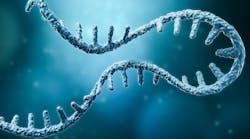The first thing to remember is that Analytical Chemists (ACs) and Biochemists (BCs) see the world differently. Analytical types have always worked with inferential tests: color changes, odors, precipitates (for classes of elements) and felt comfortable using “clues” to deduce the answer. Biochemists, especially in the drug industry, are always attempting to be specific. If a reaction is proceeding, what is being used and produced; if it has ended, what is left in the reactor and what was produced.
They want to know the exact composition of the “soup.” So when PAT was broached to the ACs, for example, blend uniformity testing, we felt fine just seeing that the spectra stopped changing, implying that the mixing was complete. BCs tend to want a complete analysis of the mix, feeling better with older, slower techniques. Add to this the water base of biological reactions and the matter gets (sorry) murkier. In a water-based system containing large amounts of organic materials, both in solution and suspended, UV is worthless; mid-range IR sees the water, and even NIR has limitations. Raman, as it keeps improving is becoming more applicable, but the literature references are still few and far between.
I believe that for batch-fed fermentation even a simple NIR probe can help. By simply observing the reaction has stopped (spectral changes have stopped), the data may be used as a monitor to time conventional sampling. Since bioprocess can vary in rate and yield from lot to lot, taking samples at pre-set time points is not the best approach; using spectra is a viable tool. As time and the number of batches progresses, the spectra, information of the starting materials and in-process analyses can be modeled using multivariate software and predictions can be made with confidence.
One major difficulty in transferring PAT experience from solid dosage forms to biotech is that they are not the same thing. When you look at process controls and analyses from other industries (i.e., fine chemicals, petrochemicals and detergents), you see chemical reactions, usually in non-aqueous solvents. In addition, the added materials are most often well-analyzed and characterized chemicals. And (I know, all my Organic Chemist friends will hate this) the kinetic pathways are relatively simple to work out and control.
In the medicinal field (small molecule dosage form production), you see physical manipulations (i.e., blending, wetting and agglomeration, drying, tableting, etc.), not chemical reactions. In other words, successful PAT programs in small molecules are not directly applicable to biotech/macromolecules. In the latter, the “process” is, indeed, chemical and more closely related to the other industries and API manufacturing — except for the water-based reactions and with much more complex chemistry.
Add to that the backgrounds of the relative staffs: in small molecule manufacture, you have engineers, pharmacists, analytical chemists, pharmacologists, and so forth. In the biotech industry you have biochemists. The paradigm that has been followed in biotech is that the people who do the research are, in essence, the people who are in charge of production and analysis. Unfortunately, as Maslow put it, “when the only tool you have is a hammer, every problem resembles a nail.”
When all the people in a facility (remember, biotech firms only recently — compared with SM companies — began production; they were research sites for decades) have similar backgrounds, there is scant pressure to look for different approaches. Their training has been to carefully examine and catalog every part of a bio-mixture, without a voice from the lab, suggesting NIR or Raman as a monitoring tool.
The good news is that there are some mergers that will move the PAT battle lines. As larger Pharma companies buy or merge with Biopharma companies, they also bring two things of note: 1) the strong desire to cut costs (they have been under “generic-attack” for decades and government-costs attack for years) and 2) expertise in the PAT/QbD arena. I foresee, then, a rapid “catch-up” and, with biosimilar pressure, a rapid advance of PAT in Biopharma.





